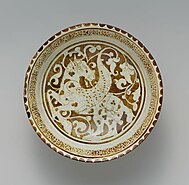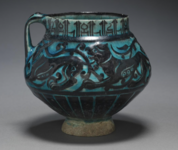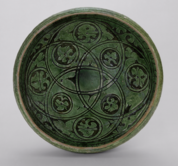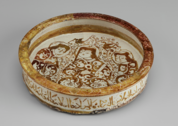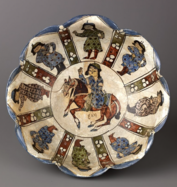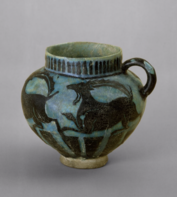
Islamic art is a part of Islamic culture and encompasses the visual arts produced since the 7th century CE by people who lived within territories inhabited or ruled by Muslim populations. Referring to characteristic traditions across a wide range of lands, periods, and genres, Islamic art is a concept used first by Western art historians in the late 19th century. Public Islamic art is traditionally non-representational, except for the widespread use of plant forms, usually in varieties of the spiralling arabesque. These are often combined with Islamic calligraphy, geometric patterns in styles that are typically found in a wide variety of media, from small objects in ceramic or metalwork to large decorative schemes in tiling on the outside and inside of large buildings, including mosques. Other forms of Islamic art include Islamic miniature painting, artefacts like Islamic glass or pottery, and textile arts, such as carpets and embroidery.
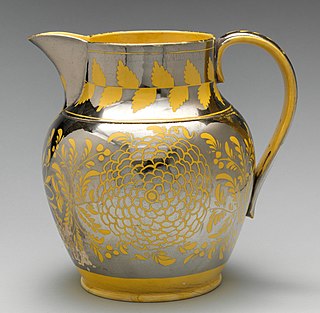
Lustreware or lusterware is a type of pottery or porcelain with a metallic glaze that gives the effect of iridescence. It is produced by metallic oxides in an overglaze finish, which is given a second firing at a lower temperature in a "muffle kiln", or a reduction kiln, excluding oxygen.

Islamic pottery occupied a geographical position between Chinese ceramics, and the pottery of the Byzantine Empire and Europe. For most of the period, it made great aesthetic achievements and influence as well, influencing Byzantium and Europe. The use of drinking and eating vessels in gold and silver, the ideal in ancient Rome and Persia as well as medieval Christian societies, is prohibited by the Hadiths, with the result that pottery and glass were used for tableware by Muslim elites, as pottery also was in China but was much rarer in Europe and Byzantium. In the same way, Islamic restrictions greatly discouraged figurative wall painting, encouraging the architectural use of schemes of decorative and often geometrically patterned titles, which are the most distinctive and original speciality of Islamic ceramics.

Buncheong (Korean: 분청), or punch'ong, ware is a traditional form of Korean stoneware, with a blue-green tone. Pieces are coated with white slip (ceramics), and decorative designs are added using a variety of techniques. This style originated in the 15th century and continues in a revived form today.

Tin-glazing is the process of giving tin-glazed pottery items a ceramic glaze that is white, glossy and opaque, which is normally applied to red or buff earthenware. Tin-glaze is plain lead glaze with a small amount of tin oxide added. The opacity and whiteness of tin glaze encourage its frequent decoration. Historically this has mostly been done before the single firing, when the colours blend into the glaze, but since the 17th century also using overglaze enamels, with a light second firing, allowing a wider range of colours. Majolica, maiolica, delftware and faience are among the terms used for common types of tin-glazed pottery.
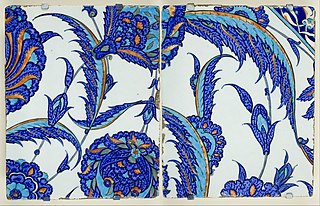
Iznik pottery, or Iznik ware, named after the town of İznik in Anatolia where it was made, is a decorated ceramic that was produced from the last quarter of the 15th century until the end of the 17th century. Turkish stylization is a reflection of Chinese Porcelain.

Fritware, also known as stone-paste, is a type of pottery in which frit is added to clay to reduce its fusion temperature. The mixture may include quartz or other siliceous material. An organic compound such as gum or glue may be added for binding. The resulting mixture can be fired at a lower temperature than clay alone. A glaze is then applied on the surface.
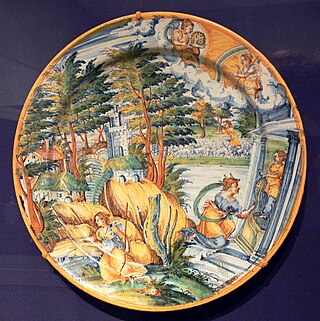
Tin-glazed pottery is earthenware covered in lead glaze with added tin oxide which is white, shiny and opaque ; usually this provides a background for brightly painted decoration. It has been important in Islamic and European pottery, but very little used in East Asia. The pottery body is usually made of red or buff-colored earthenware and the white glaze imitated Chinese porcelain. The decoration on tin-glazed pottery is usually applied to the unfired glaze surface by brush with metallic oxides, commonly cobalt oxide, copper oxide, iron oxide, manganese dioxide and antimony oxide. The makers of Italian tin-glazed pottery from the late Renaissance blended oxides to produce detailed and realistic polychrome paintings.
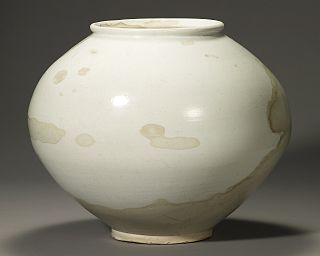
Moon jar is a type of traditional Korean white porcelain which was made during the Joseon dynasty (1392–1910). The Joseon white porcelain was adopted as imperial ware in the fifteenth century. Moon jars first appeared in the late seventeenth century and remained popular until the mid-eighteenth century. However, they were not nicknamed “moon jars” until the 1950s. The name comes from its shape and milky color of the glaze to resemble the coloration of the moon. This type of vessel is unique to the Joseon Dynasty and were never produced in China or Japan.

Chinese influences on Islamic pottery cover a period starting from at least the 8th century CE to the 19th century. The influence of Chinese ceramics on Islamic pottery has to be viewed in the broader context of the considerable importance of Chinese culture on Islamic arts in general.
The Khwarazmian or Khwarezmian Empire was a culturally Persianate, Sunni Muslim empire of Turkic mamluk origin. Khwarazmians ruled large parts of present-day Central Asia, Afghanistan, and Iran from 1077 to 1231; first as vassals of the Seljuk Empire and the Qara Khitai, and from circa 1190 as independent rulers up until the Mongol conquest in 1219–1221.
Abū Zayd ibn Muḥammad ibn Abī Zayd, commonly referred to as Abu Zayd or Abu Zayd al-Kashani, was a Medieval Persian potter, who was most active between the late 12th and early 13th century. He came from Kashan, which was a city in the northern part of Isfahan in Iran, first under the Seljuq Empire, then from 1194 under the Khwarizmian Empire. As such, his works represented the Turco-Persian culture of the time. As a very aggressive potter, who was highly skilled, he was able to work on 15 or more masterpieces, and his collection is larger than that of any other medieval Iranian potter. The collection includes both luxury items and artifacts at the time, and other artistic items: lustreware and mina'i ware. He also wrote poetry, some of which was inscribed on his pottery.

Persian pottery or Iranian pottery is the pottery made by the artists of Persia (Iran) and its history goes back to early Neolithic Age. Agriculture gave rise to the baking of clay, and the making of utensils by the people of Iran. Through the centuries, Persian potters have responded to the demands and changes brought by political turmoil by adopting and refining newly introduced forms and blending them into their own culture. This innovative attitude has survived through time and influenced many other cultures around the world.

Ceramic art is art made from ceramic materials, including clay. It may take varied forms, including artistic pottery, including tableware, tiles, figurines and other sculpture. As one of the plastic arts, ceramic art is a visual art. While some ceramics are considered fine art, such as pottery or sculpture, most are considered to be decorative, industrial or applied art objects. Ceramic art can be created by one person or by a group, in a pottery or a ceramic factory with a group designing and manufacturing the artware.

Persian art or Iranian art has one of the richest art heritages in world history and has been strong in many media including architecture, painting, weaving, pottery, calligraphy, metalworking and sculpture. At different times, influences from the art of neighbouring civilizations have been very important, and latterly Persian art gave and received major influences as part of the wider styles of Islamic art. This article covers the art of Persia up to 1925, and the end of the Qajar dynasty; for later art see Iranian modern and contemporary art, and for traditional crafts see arts of Iran. Rock art in Iran is its most ancient surviving art. Iranian architecture is covered at that article.

Mina'i ware is a type of Persian pottery, or Islamic pottery developed in Kashan, Iran, in the decades leading up to the Mongol invasion of Persia in 1219, after which production ceased. It has been described as "probably the most luxurious of all types of ceramic ware produced in the eastern Islamic lands during the medieval period". The ceramic body of white-ish fritware or stonepaste is fully decorated with detailed paintings using several colours, usually including figures.

Susa is one of the most important archaeological sites in Iran, on the border between the Mesopotamian world and the Persian world. Inhabited since very ancient times, it remained occupied until the middle of the 15th century. Excavations carried out by French teams, allowed the discovery of many objects, including a large production of ceramics dating from the Islamic period, currently kept for a large part at the Louvre.

Ewer with the head of a rooster is a ceramic ewer kept in the department of Islamic arts of the Louvre museum. It is representative of a type of production found in the art of the Seljuk dynasty of Iran of the 13th century.

Lajvardina-type ceramics were developed in the 13th century following the Mongol invasion of Persia. It was produced throughout the Ilkhanate reign. It is characterized by its deep blue color and often features geometric patterns or foliage inlaid with gold leaf. The style was created using overglaze enamel. An initial layer of dark blue glaze, produced from cobalt, was applied, followed by another layer, often gold, on which the details were painted. It was primarily produced in Kashan, a center for ceramic production and lusterware in the 12th and early 13th centuries. The style was continuously used for tiles and ornamental objects from the 1260s C.E. until the mid-14th century, when production dropped significantly, coinciding with the fall of the Ilkhanate in 1335.

The art of the Seljuks of Iran refers to the art produced throughout the eastern part of the Islamic world, between the capture of Baghdad (1055) and the Mongol invasions.
